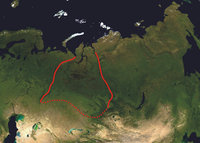
Photo from wikipedia
Abstract Mineralogical, petrographical, geochemical analyses, and fluid inclusions petrography and microthermometry were combined to investigate the basic properties of the source rock (organic matter content, kerogen type, and thermal maturity)… Click to show full abstract
Abstract Mineralogical, petrographical, geochemical analyses, and fluid inclusions petrography and microthermometry were combined to investigate the basic properties of the source rock (organic matter content, kerogen type, and thermal maturity) and sandstone reservoirs (composition, pore systems, porosity, and permeability), the hydrocarbon origin, and the formation mechanisms of the deep (>3.5 km) petroleum system in the Upper Paleogene Es1 (the uppermost member of the Shahejie Formation) in the No. 3 Structural Belt in the Nanpu Sag, Bohai Bay Basin. The results indicate that the Es1 source rock is primarily composed of dark gray mudstone and presents a set of high-quality source rocks (>500 m, average total organic carbon (TOC) 1.38%, in a mature stage (maximum pyrolysis yield of 430 °C–460 °C)). The Es1 sandstone is composed of lithic arkose formed in a braided river delta and has low porosity (average 13.4%) but moderate-high permeability (average 184.9 mD). The hydrocarbons originated from the Es1 source rocks in the Caofeidian subsag during two charging periods: 10 Ma and 3 Ma. The key factors controlling the formation of the deep petroleum system are as follows: (a) High-quality hydrocarbon supply, (b) Medium-high permeability reservoirs, (c) A favorable configuration of the source rock and reservoirs (self-generated and self-accumulated), and (d) Late hydrocarbon charging; the second factor is the most important. The medium-high permeability reservoirs are attributed to a high-energy depositional environment (distributary channels of braid delta front), a high content of rigid detrital grains (mainly quartz and metamorphic rock fragments) provided by the Archean granite provenance, and the secondary pores formed by feldspar dissolution. This study provides a new example for revealing the formation mechanisms of deep (>3.5 km) petroleum systems in the terrestrial rift basin across the Bohai Bay Basin.
Journal Title: Marine and Petroleum Geology
Year Published: 2019
Link to full text (if available)
Share on Social Media: Sign Up to like & get
recommendations!